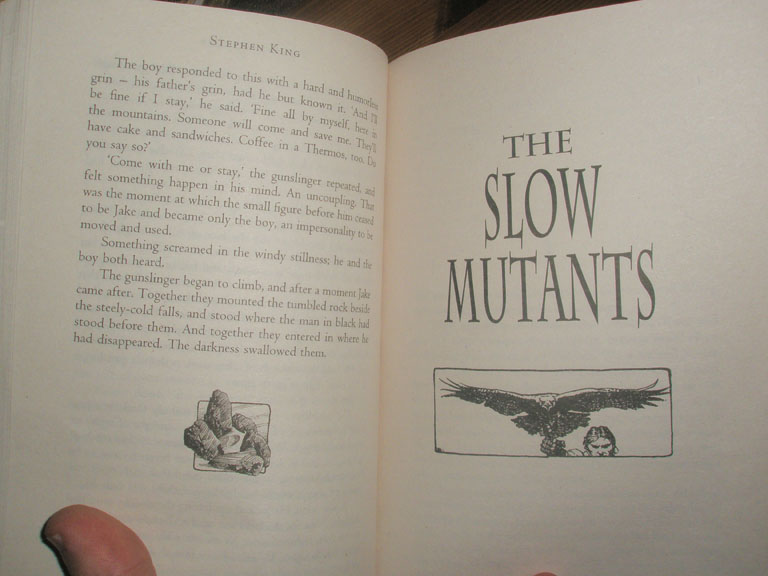What if we reviewed books like videogames?
The Dark Tower: The Gunslinger is the first in an epic fiction saga from writer Stephen King and publisher Hodder and Stoughton. It’s entering a crowded market, saturated with other titles in the fantasy genre like Lord of the Rings III: Warfare of the Ring and Wheel of Time 2011 with its newly released Book of the Year Edition. Can this gunslinger draw first blood in the book wars, or does it end up firing blanks?
The Dark Tower is a marked change for King, whose previous works include classic horror titles The Stand and The Shining. The Gunslinger was originally released as episodic content from 1978 in five parts, until its eventual launch as a bound product in 1982. 2003 saw a remake of the book, bringing it into step with later parts in the Dark Tower heptalogy. Despite the advances of modern printing technology and a high-definition lick of paint on the cover, it’s showing its age: the graphical illustrations are dated and crude.
But as we all know, it’s not about the graphics: it’s about the bookread! It’s a third person action adventure novel, where you follow the last gunslinger Roland Deschain on his quest for the eponymous Dark Tower. Pursuing the mysterious Man in Black with his companion Jake and encountering foes like the hideous Slow Mutants, Roland’s journey is a somewhat linear one. There’s little sense of agency for the reader, no optional footnotes to break up the main storyline and once finished there’s not much incentive to read it through again. While this might have been state-of-the-art storytelling back in 1982, in the days of Choose Your Own Adventure books and modern interactive fiction it’s antiquated and constricting.



The Gunslinger is an immersive tale with rich characterisation. If Roland got in a fight with Aragorn from Lord of the Rings, the King of Gondor would be shot full of holes faster than the plot of Independence Day. He is a grizzly, gnarled badass and great fun to read. Jake is a stereotypical whiny sidekick, serving to distract and force Roland into some plot exposition. Luckily you’re not forced to step into Jake’s shoes at any point, but perhaps some variation would have been nice. In a frustrating move, the book ends on a cliffhanger and merely whets the appetite for a sequel. It nearly feels like a cynical cash-in on the part of the author, but King does state that it is merely the first part of the series.
Despite its engrossing story and great bookread, The Gunslinger suffers from some serious technical deficiencies. There is little to no music, save for the realistic rustling of pages as you read and the ambience of passing traffic outside your bedroom window. Although it’s easy to save your place in the story with the now obligatory bookmark feature, the book doesn’t automatically save your progress. In one intense reading session, I dropped the book on the floor, which led to several minutes of frustrating backtracking. It’s not easy to re-read previous chapters once you’ve finished them unless you keep a series of bookmarks, but that just takes up space in the paperback and can result in resuming from the wrong bookmark if you’re not careful. As an experienced reader and with careful bookmarking, I finished the story in six hours, but newcomers might stretch it out to eight or ten.


As you’d expect from a novel released in the 1980s, there is no online functionality and limited multi-reader activity on offer. I tried reading it to a friend, but the co-operative elements weren’t as good as, say, a book of crosswords. Hodder and Stoughton have cynically removed Chapter 9 from the book, although it doesn’t affect the overall narrative to a great extent, and will be releasing it as paid DLPC (downloadable, printable content) in the near future so readers can awkwardly glue it into the blank space in the book. There are also some glaring text errors: Stephen King has promised a patch in the form of a packet of stickers, which should be available for free from his website in the next couple of weeks.
The Gunslinger remains a classic work of fiction, even if it has aged and might be hard for modern readers to appreciate with their ever-decreasing attention spans. It’s a slow burner (not literally: the book is highly flammable) but a rewarding experience that comes highly recommended to fans of the genre. Give it time to holster your attention and it will have you turning pages like you’re animating a flick book: even if it’s been overlooked in favour of more famous alternatives, it still goes out guns blazing.






